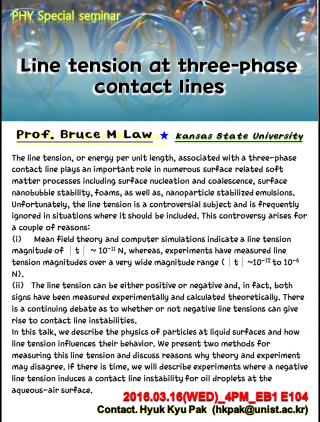자연과학부 물리학과 세미나 개최

Pl"'O,:f;~ Qt'UC.e M r.· f...~~ * ko,nsas S-ta-te Universi-tv
ThQ linQ tQnsi 。n, 。r QnQr9y pQr unit IQn9th, ass。ciatQd with a thrQQ-phasQ
c。nta야 linQ plays an imp。rtant rolQ in numQrous su~acQ ,、QlatQd s。-Ft
mattQr pr。cQSSQS including su~acQ nuclQation and c。alQScQncQ, sur‘-FacQ
nanobubblQ stability, foams, as WQll as., nan。particlQ stabili?Qd Qmulsions.
Unf。rtunatQly, thQ linQ tQnsion is a controVQr‘sial subjQct and is frQquQntly
i9n。rQd in situati 。ns WhQr‘e it should be includQd. This c。ntrovQr‘sy arisQs for
a c。upIQ 。F rQason~‘:
(i) MQan fiQld thQor‘9 and computer simulati 。ns indicate a line tensi 。n
magnitude of J t J "' 10-11 N, wher‘eas, experiments have measured line
tensi。n magnitudes over a very wide magnitude range ( J t J "'10-12 to 10-6
N).
(ii) The line tension can be either positive 。r negative and, in fact, b。th
signs have been measured experimentally and calculated the。r‘etically. There
is a c。ntinuing debate as t。whether、。r n。t negative line tensions can give
rise t。c。ntact line instabilities.
In this talk, we describe the physics 。F parti 디es at liquid su~aces and h。w
line tension influences their behavi 。r‘. We present two methods for
measuring this line tensi 。n and discuss reasons why theor‘9 and experiment
may disagree. If there is time, we wi” describe experiments where a negative
line tension induces a contact line instability for‘ 。ii droplets at the
aqueous-air su~ace.
2018.03.애(W를D)_빼M_틈81 틈1CM
Contact. Hyuk Kyu Pak (hkpak@u메st.ac.kr)
ThQ linQ tQnsi 。n, 。r QnQr9y pQr unit IQn9th, ass。ciatQd with a thrQQ-phasQ
c。nta야 linQ plays an imp。rtant rolQ in numQrous su~acQ ,、QlatQd s。-Ft
mattQr pr。cQSSQS including su~acQ nuclQation and c。alQScQncQ, sur‘-FacQ
nanobubblQ stability, foams, as WQll as., nan。particlQ stabili?Qd Qmulsions.
Unf。rtunatQly, thQ linQ tQnsion is a controVQr‘sial subjQct and is frQquQntly
i9n。rQd in situati 。ns WhQr‘e it should be includQd. This c。ntrovQr‘sy arisQs for
a c。upIQ 。F rQason~‘:
(i) MQan fiQld thQor‘9 and computer simulati 。ns indicate a line tensi 。n
magnitude of J t J "' 10-11 N, wher‘eas, experiments have measured line
tensi。n magnitudes over a very wide magnitude range ( J t J "'10-12 to 10-6
N).
(ii) The line tension can be either positive 。r negative and, in fact, b。th
signs have been measured experimentally and calculated the。r‘etically. There
is a c。ntinuing debate as t。whether、。r n。t negative line tensions can give
rise t。c。ntact line instabilities.
In this talk, we describe the physics 。F parti 디es at liquid su~aces and h。w
line tension influences their behavi 。r‘. We present two methods for
measuring this line tensi 。n and discuss reasons why theor‘9 and experiment
may disagree. If there is time, we wi” describe experiments where a negative
line tension induces a contact line instability for‘ 。ii droplets at the
aqueous-air su~ace.
2018.03.애(W를D)_빼M_틈81 틈1CM
Contact. Hyuk Kyu Pak (hkpak@u메st.ac.kr)
2016년 03월 16일(수)
16:00
- 장소 : 제1공학관 E104호
- 담당부서 : 자연과학부
- 담당자 : 김지향
- 연락처 : 052-217-3603
자연과학부 물리학과는 3월 16일(수) 오후 4시부터 제1공학관 E104호에서 세미나를 개최합니다. 미국 캔자스주립대학교의 부르스 라우 교수가 강사로 나섭니다.
-
Previous Post
글로벌 제약산업 현황 및 한미약품 R&D 세미나
-
Next Post
에너지 및 화학공학부 세미나 2016-2 개최
